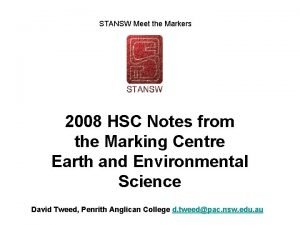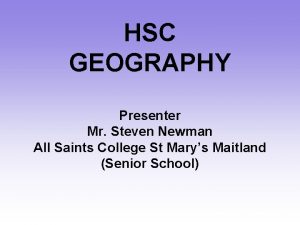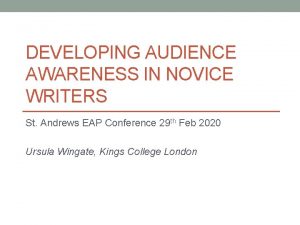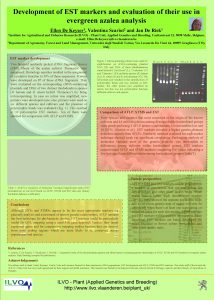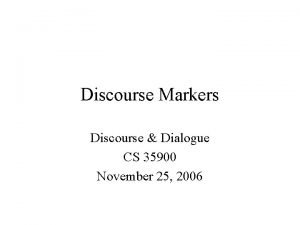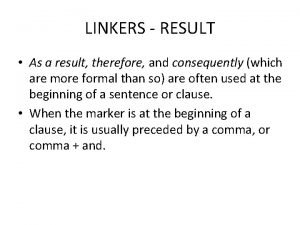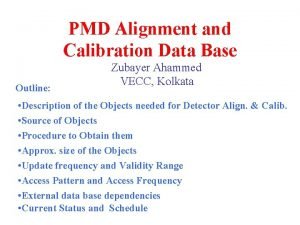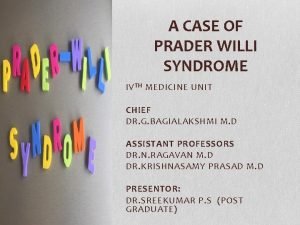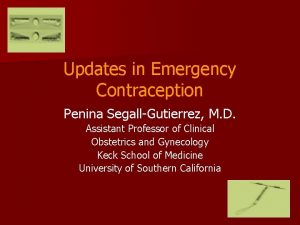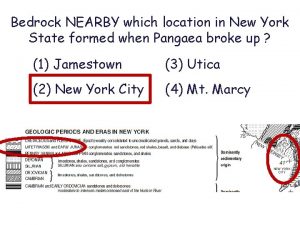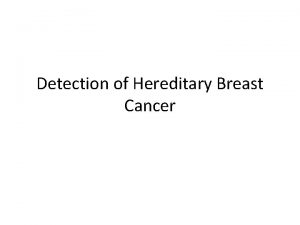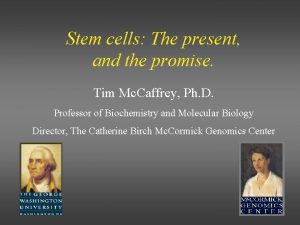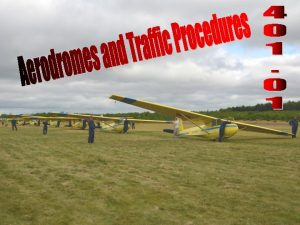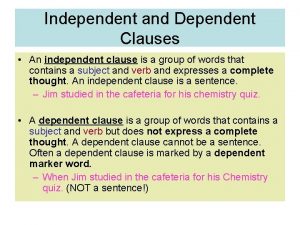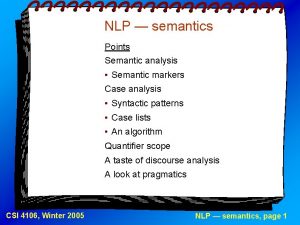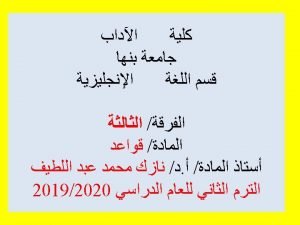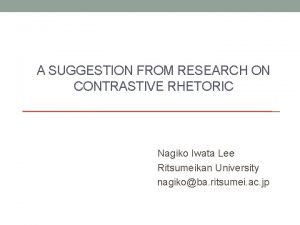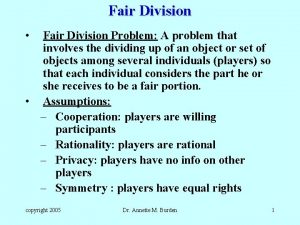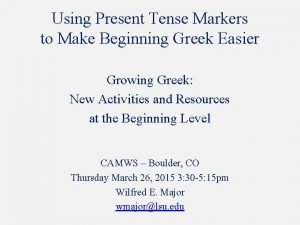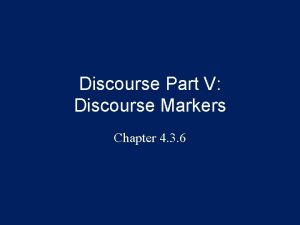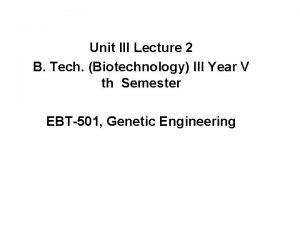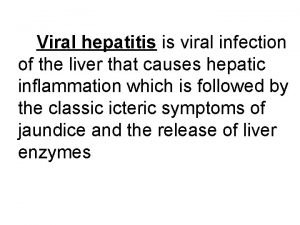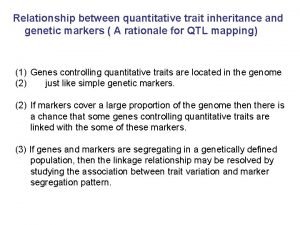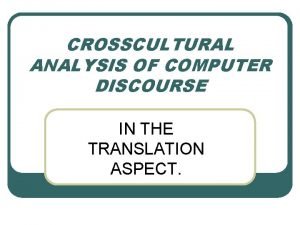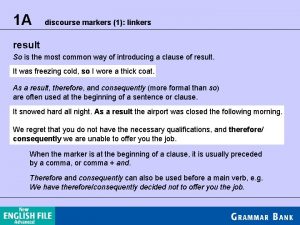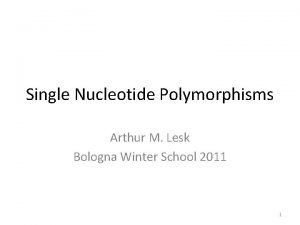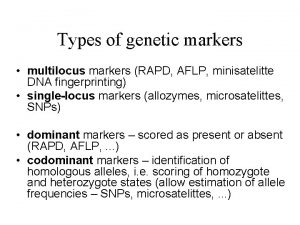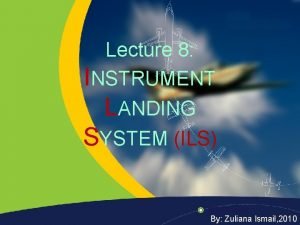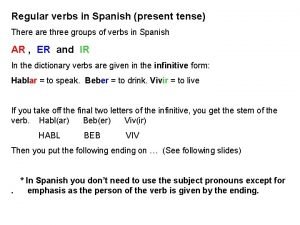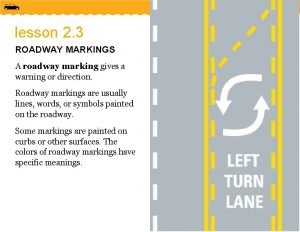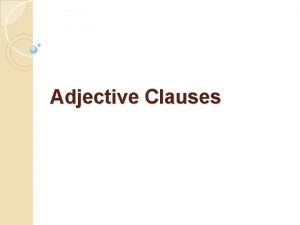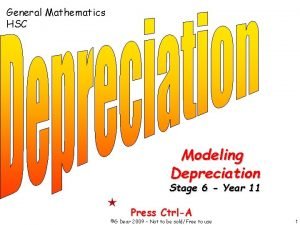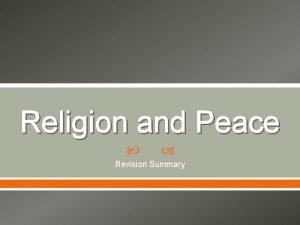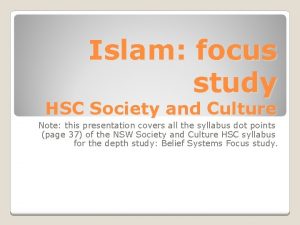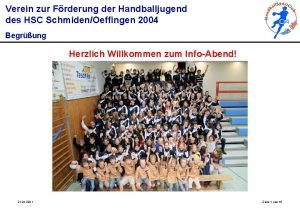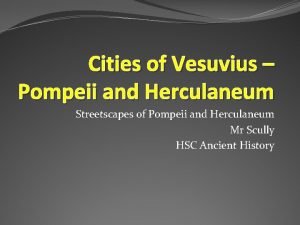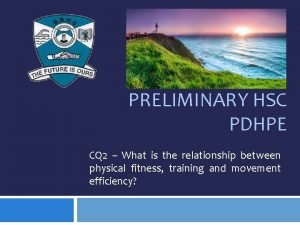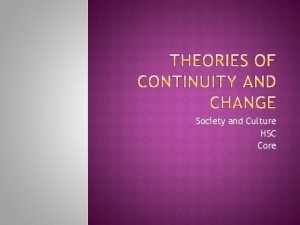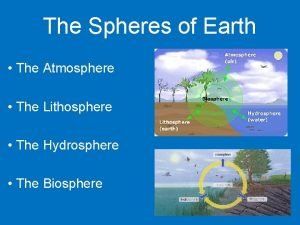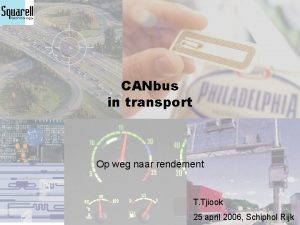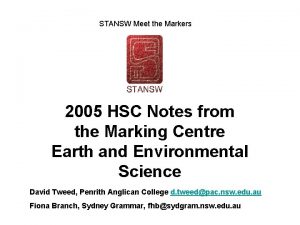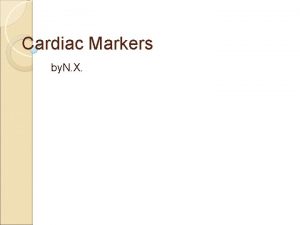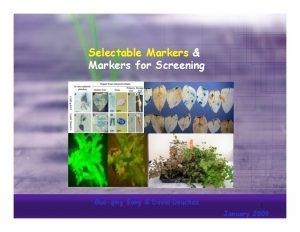STANSW Meet the Markers 2007 HSC Notes from















































































































































- Slides: 143

STANSW Meet the Markers 2007 HSC Notes from the Marking Centre Earth and Environmental Science David Tweed, Penrith Anglican College d. tweed@pac. nsw. edu. au

General Comments • 1240 candidates attempted the Earth and Environmental Science examination. • The most popular electives were Introduced Species and the Australian Environment (78%) and Oceanography (8%).

Content • examiners may write questions that address the syllabus outcomes in a manner that requires candidates to respond by integrating their knowledge, understanding and skills developed through studying the course, including the Prescribed Focus Areas. • It is important to understand that the Preliminary HSC course is assumed knowledge for the HSC course.

Depth of treatment • Candidates need to be reminded that the answer space provided and the marks allocated are guides to the maximum length of response required. • Candidates should use examination time to analyse the question and plan responses carefully, working within that framework to produce clear and concise responses. – dot points, – diagrams and/or – tables, • holistic questions which need to be logical and well structured. • confused the terms and concepts of – global warming and ozone depletion – the Cambrian Explosion with a mass extinction event.

Better Responses • Better responses indicate that candidates are following the instructions provided on the examination paper. In these responses, candidates: • show all working where required by the question • do not repeat the question as part of the response • look at the structure of the whole question and note that in some questions the parts follow from each other, ie responses in part (a) lead to the required response in part (b) etc • use appropriate equipment, for example, pencils and a ruler to draw diagrams and graphs. (A clear plastic ruler would aid candidates to plot points that are further from the axes and rule straight lines of best fit. )

Option Answers • In Section II, the option question is divided into a number of parts. Candidates should clearly label each part of the question when writing in their answer booklets. • In part (d) of the 2007 option questions, the best responses presented ideas coherently and included the correct use of scientific principles and ideas. • Many candidates wrote a lot of information that was not relevant to the question. • Some responses showed evidence of rote learning an anticipated answer. These responses did not address the syllabus content and/or outcomes being assessed and hence did not score full marks. • Candidates are required to attempt one question only in Section II, but some candidates responded to more than one option question. • Candidates are strongly advised to answer the option they have studied in class.

2007 Scaling of EES http: //www. uac. edu. au/pubs/pdf/2007_table_A 3. pdf
















Part B Question 16 (a) Most responses correctly identified a modern technology. Weaker responses did not address the term ‘technology’. 16 (a) Laser reflection devices across fault lines

Question 16 (b) Better responses described a modern technology such as lasers placed across a fault line such as the San Andreas Fault. Some better responses answered the question with a labelled scientific diagram. Weaker responses lacked details of how devices worked to measure relative motion, particularly those regarding GPS and other satellite technologies. Weaker responses did not address time, distance and/or repeated measurements. (b) This piece of technology uses lasers in the aid of comparing the past with the present measurements. The two ends of the geodimeter are located either side of a transform fault plate boundary and as the plates move relative to each other the laser measures the relative movement.


Question 17 (a) In better responses, candidates constructed a table and correctly identified the required three properties of the respective lithospheric plates. The best responses used terminology such as mafic/felsic in reference to mineralogy, and density rather than referring to weight. Weaker responses confused tectonic processes with properties.

17(a) Comparing lithospheric plates Continental Crust Oceanic Crust -Lighter -Thick ~ 75 km -Felsic and intermediate composition -Rhyolite granite dolerite andesite -Older -Dense -Thin ~5 -8 km -Mafic composition -Basalt Gabbro -Younger destroyed more rapidly

(b) Better responses described the role of density and gravity as key features of the slab pull hypothesis, and correctly used these features to explain the continued motion of the lithospheric plates.

(b) Slab Pull at subduction zones the heavier (denser) plate subducts under the lighter plate. As the plate subducts it pulls the remainder of the plate with it due to gravity (weight) forces. The plate continues to pull itself under moving the entire plate and helping to drive the plate motion.

Question 18 (a)(i) The majority of responses correctly identified either a specific disaster such as the eruption of Mt St Helens in 1980 or a general disaster such as an earthquake, tsunami or volcanic eruption. Weaker responses named a place such as Mt Pinatubo or Newcastle but did not associate it with an actual disastrous event. 18 (a)(i)Tsunamis – Boxing day Tsunami 2005 caused by massive Earthquake

(ii) Better responses concentrated on specific tectonic processes such as plate subduction with partial melting of the subducting plate, leading to volcanic eruptions. Earthquakes were associated with a build up of stress due to plate interaction with sudden release of energy at the fault line, generating an earthquake. In many of the better responses, actual plates were named. Labelled scientific diagrams were often included as part of the better responses. Weaker responses simply described the hazards associated with the disaster rather than explaining the causes of them. (a) (ii) At the subducting boundary between the indo Australian plate and the Eurasian plate the tip of the over riding plate was displaced by the forces of subduction and was then suddenly released back displacing a massive amount of ocean causing the Tsunami.

(b) Better responses linked the production and weathering of igneous material to increased soil fertility. This was then directly associated with increased crop yields. Many responses mentioned mineral ions such as iron and magnesium as important contributors to soil fertility. There was evidence that some candidates misinterpreted the question and referred to the hazards of farming in volcanic areas instead of the advantages. Weaker responses discussed only cultural or aesthetic reasons for farming in these regions and did not address the scientific focus of the question.

(b) people risk farming in active volcanic areas because of the rich fertile soils resulting from the volcanic ash and weathered volcanic rock. The rich fertile soils increases crop yields and increases productivity so it is more profitable farming near volcanoes. The height of the volcano can also increase the local rainfall.

Question 19 A variety of appropriate scale diagrams were used, eg pie charts, timelines and histograms. The best responses correctly identified the eons, their relative sizes and the scale used and/or the duration of the eons. In the better responses, candidates referred to the geological timescale provided. In better responses, candidates used a ruler and a calculator where appropriate to accurately construct their diagram.


(a) Many of the weaker responses incorrectly included CFCs, methane and acids. 20 (a) Carbon Dioxide, Sulfur Dioxide

Question 20 (b)The best responses demonstrated that the fuel was combusted with oxygen to produce the exhaust emission. In weaker responses, there was evidence of confusion between the equation for combustion and those for respiration, photosynthesis and acid rain formation. (b) Hydrocarbon + Oxygen → Carbon Dioxide + Water

Question 21 (a) The better responses demonstrated an understanding of increased diversity in a short period of time, while the weaker responses misunderstood the word explosion, taking it to mean the meteorite collision with the Earth at the end of the Permian. (b) Better responses gave two examples of differences between the groups but weaker responses only identified the presence or lack of hard parts as a feature of difference.

21(a) The fossil record displays a sudden radiation of new species, particularly those with hard shells(exoskeletons). There was great abundance diversity of new organisms. (b) (1) Ediacaran metazoans were soft bodied whilst the organisms of the Cambrian had a hard exoskeleton, some armour or shell protection and generally some protective mechanism(eg trilobite) (2) Ediacarans seemed to float or drift with the ocean currents whilst the Cambrian fauna possessed new mechanisms to enable faster movement including muscle attachments meaning faster movement.

21 (c) 1 Hard shell allowed for protection against the elements (such as the prevention of dessication as it held the soft organs within). 2 Hard shell also enabled the Cambrian fauna to defend against predators. 3 Spines act as deterants to attackers 4 Allowed for easier predation of others as they had muscle attachment to the exoskeleton for faster movement and Attacking parts like jaws and teeth



Question 22 Better responses presented an analysis of the data. Better responses directly referred to the information in the stem of the question but weaker candidates failed to recognise the significance of this information. Weaker responses demonstrated knowledge of theories for the Permian Mass Extinction but failed to apply that knowledge to the data. Many responses focused on describing the depositional environment of the rock layers rather than the processes and events which caused the changes in fossil numbers, diversity and dominant types.

22 The sequence of rocks shows the fossil abundance and number dropping dramatically From the Permian limestone to the Early Triassic shale following two volcanic ash layers. If this occurred globally it is likely to be the mass extinction separating the palaeozoic from the Mesozoic era. This was thought to occur due to the reforming of a super continent. The convergence of Ocean/Ocean and oceanic continental plates led to the formation of a large number of volcanoes on earth. The eruption of many of thes around the same time would account for the layers of volcanic ash found in the rock sequence. The presence of rock and ash particles in the atmosphere is thought to have blocked the suns rays from reaching the earth causing a period of global cooling and subsequent sea level drops as the poles froze over. This reduces the habitat areas of many organisms and combined with being unable to withstand the cooler temperature a huge number and range of organisms became extinct as evidenced in the decrease of the numbers of fossils found. The increase in fossil species and abundance in the middle Triassic shale rock layer and the change in dominant fossil groupings displays the explosive adaptation that occurs following a mass extinction.


Question 23 Better responses demonstrated an understanding of the term technology and gave multiple examples of how technology had improved our understanding of fossil life forms. They referred to specific technologies and described how these have enabled us to improve our understanding.

23 Exponential advancements in technology have improved our understanding of fossils, their formation and background. Using computer analysis we can create images of fossils digitally giving us a better understanding of their form such as shape size transport and respiratory systems. Advancements in submarine transport such as sending unmanned submarines into deep ocean environments allows us to uncover new types of fossils which give us a better understanding of their evolution. Using technology we can simulate past environments and analyse the environment that the fossilised life forms lived in. We can use more accurate absolute dating to determine when the life form existed and place it in the evolutionary tree. An example of this would be the use of technology in the current analysis of ice cores analyse the atmospheric composition of the early earth and therefore the environment the life forms existed in and ultimately how they were fossilised.


Question 24 (a) In the better responses, candidates clearly labelled the inputs and outputs in their diagrams. In weaker responses, flowcharts of an industrial process were drawn rather than a classroom simulation of a process.

24 (a) DIAGRAM Filtration Water and Dirt mix Filter paper Retort stand clamp Filter Funnel Beaker The dirt and water mix was filtered by the filter paper and the “clean” water was found in the beaker

Question 24 (b)Better responses included reference to the results of their simulation as well as referring to successes and limitations of the simulation.

(b) For a simple filtration experiment I feel it was an effective experiment as it successfully displayed how solids were removed via a filtration process. It was limited in its success of filtering the water (it did still possess a brown tinge from the dirt). as well as its scale. This simulation could not for example treat large scale amounts of water and the filter paper would need to be continually cleaned as build up of particles would stop the process.

Question 25 a) Use of the pest's natural predators (biological control)

Question 25 b ) The ozone layer protects organisms by filtering UV radiation which can damage DNA.

(c) Better responses used diagrams and word equations to explain all the necessary steps leading to the depletion of ozone. Weaker responses outlined only some of the steps. Some responses showed that candidates were not aware that halides include CFCs.

Question 25 c ) -CFC (or other complex molecule) + UV light = free radical (halide ion) -free radical + ozone = oxygen gas + chloride monoxide -chlorine monoxide + free oxygen radical = oxygen gas = chlorine radical The halide is freed from the complex molecule by UV light. This reacts with the ozone molecule to produce chlorine monoxide and oxygen gas. Chlorine monoxide can react with a free oxygen radical/atom to produce oxygen gas. The chlorine atom/ion if left to repeat the process.

(d) Better responses named an existing scientist and/or organisation and outlined current research rather than research from the 1990 s. Weaker responses made general responses about Australia’s role in ozone research and restated the question. Question 25 d) CSIRO in Antarctica are using weather balloons and satellites images are continually monitoring the thickness of the ozone layer and the amount of pollutants.


Question 26 Better responses discussed multiple issues, providing arguments for and/or against each. They also related each issue to the long-term use of a chemical and its consequences. Weaker responses listed the issues (such as bioaccumulation and biomagnification in food chains/webs) and provided arguments for and/or against them. They used specific examples of pesticides to argue the issues, including the impact on non-target species. However, they gave minimal detail, only mentioning ‘harm’ or ‘suffer’ in their negative arguments instead of more specific effects on the environment.

26 Exemplar Response Note: any two of the following issues and their arguments and any one consequence. When new pesticides are continually introduced into the environment, the potential for non-target species to be eliminated from the food chain increases. This disruption to the food chain leads to a decrease in the biodiversity of an ecosystem. A pest species may develop multiple resistances to multiple pesticides over many generations. This immunity ultimately leads to the formation of 'Super-Pests' which are unable to be controlled through conventional pesticide use, alternatively, stronger pesticides are needed. Bioaccumulation/Biomagnification in a non-target species, ultimately leading to death or deformities in the offspring, interrupts the food chain, leading to a decrease in the ecosystems biodiversity. Pesticides linked to the depletion of ozone in the atmosphere can increase the amount Of UV radiation penetrating the Earths atmosphere can increase global temperatures therefore adding to the greenhouse effect, changing global climate. Persistence of the pesticide in soil affecting future generations and maintaining Bioaccumulation/ Biomagnification issues well into the future even after the use of the pesticide has ceased.


Question 27 Better responses assessed the recency of the article, the support provided by other scientific studies and the validity of the source of the data and its author. These could be stated in general terms without reference to the stimulus provided. Weaker responses included only one or two features of assessment and tried to summarise the article rather than to actually assess its value as a piece of science reporting. Many candidates focused on the ‘assess’ part of the question rather than the more general ‘how’ to assess the reliability.

27 Articles such as this would generally be unreliable. Even though it may have been written recently it appears in a daily newspaper which may lack credibility in scientific circles. Many of the statements made in the article are not supported by scientific studies and further research would be needed.

Question 28 (a) (i) Better responses acknowledged that biological controls were used to reduce the numbers of another species. Weaker responses confused biological control with control by pesticides while others simply re-stated the question in definition form.

28 a(i) Biological control is the introduction of a species to reduce the numbers of a pest species. examples could be predator/prey, disease/host or even release of sterilised males.

Question 28 (a) (ii) Better responses named an appropriate type of control, used a current Australian example and clearly identified the effect of the control agent on the target species. They also tended to use a well-documented biological control such as the cactoblastis moth and Prickly Pear.

a (ii) One example is the Cactoblastis moth which was introduced to control the numbers of prickly pear cactus. The moth lays its eggs in the cactus and when the caterpillars hatch they eat the fleshy leaves of the plant and kill it. This has been a successful control as the moth only attacks the prickly pear.


Question 28 (b) (i) Better responses indicated the trend as a rapid increase between 1800 and 1860 and then related this increase to the increasing colonisation of Australia and the deliberate or accidental importation of mammals for a range of appropriate reasons. Weaker responses failed to explain the causes of the trend.

b(i) There is a dramatic increase in numbers of mammals introduced from 1800 -1860. This is most likely due to the rapid population growth of Australia at the time. The use of mammals as food and transport as well as for hunting was so important to the Europeans that they brought many of these species with them.


Question 28 (b) (ii) The best responses clearly stated two mechanisms for accidental introduction and, for each mechanism, gave detailed characteristics and named examples. The best responses clearly explained how the organisms arrived in Australia.

b(ii) Many species have accidentally been introduced through ballast water from ships being released into Australian harbours. Empty boats take on water as ballast in foreign ports to stabilise the ship. When they arrive in Australia they take on cargo and release the ballast water which may contain eggs of possible pest species. One example is the North Pacific sea star which has become a pest in Tasmanian waters. Another method of accidental introduction can be the introduction of plant material on the soles of travellers shoes. Mud on the soles of peoples shoes may contain seeds or spores which can be brought into the country and then released into the environment as the mud on the shoe falls off.


Question 28 (c) (i) The best responses provided easily testable hypotheses. In doing this, candidates avoided subjective terms such as ‘overpower’ or ‘effect’ and chose terms that related directly to measurable characteristics. c (i) There will be fewer introduced plant species within natural (undisturbed) temperate rainforest than adjacent to areas disturbed by urban development in Kiama.

Question 28 (c) (ii) The best responses clearly reflected a thorough first-hand investigation where measurement and identification tools were used and comparisons of data or conditions were made.

(ii)The % cover of each introduced and each endemic plant species was researched within 1 m x 1 m quadrants placed every 10 m along a 50 m transect running from the urban margin into undisturbed temperate rainforest. 1 A reference key was used to identify flora. 2 Transects were replicated by class groups. 3 Percentage cover of species was recorded in a spreadsheet and populations of introduced species in disturbed and undisturbed areas were compared.

Question 28 (c) (iii) The best responses identified the risk and then the prevention method to reduce/eliminate it. (iii)For working outdoors in strong sunlight, sunscreen and hats were required to stop sun burn.

Question 28 (d) Better responses clearly distinguished between the biotic and abiotic components and related these back to the species and its effects on the environment. The best responses demonstrated a logical structure. Better responses chose an appropriate example of an introduced species, such as rabbits, salvinia or lantana, which allowed candidates to discuss both biotic and abiotic effects.


d Introduced species: Salvinia invades bodies of water Effect on the Abiotic : salvinia can double in size rapidly and so can cover large bodies of water quickly. Salvinia creates a barrier that prevents the sunlight reaching the aquatic plants and thus reduces the levels of oxygen in the water body as these plants then cannot photosynthesise properly. Salvinia also creates a problem when it dies as it sinks to the bottom of the water body and as it does so, increases the turbidity of the water. Effect on the Biotic: Because of decreased sunlight in the water body there is a lack of oxygen as plants cannot photosynthesise as well. These plants eventually die. Aquatic animals also die as a result of the decreased oxygen and reduced food source(plants). The introduction of salvinia thus greatly affects(reduces) the biodiversity of an area and can lead to conditions which favour the spread of the introduced species.


Question 28 (e) (i) The best responses used two different scales to plot rabbits and native plant seedlings. They also chose a line graph.


Question 28 (e) (ii) The best responses addressed the relationship between both factors when they were both high and low. ii There is an inverse correlation between rabbits and native plants seedlings. When the rabbit numbers increase the number of native plant seedlings decrease and visa versa.

Question 28 (e) (iii) The best responses sketched the condition in general terms rather than just identifying a condition. iii For an introduced animal to become or be perceived as a pest it must reproduce rapidly and in large numbers such that the pest out competes native flora and fauna and depletes available resources. Another condition which would enable these numbers to survive to become abundant and aid depletion is a lack of predators.

Question 29 (a) (i) The best responses identified two renewable resources. Weaker responses included nuclear energy which is not a renewable resource. (ii) The best responses outlined a specific use for their identified renewable resource and then gave a reason as to why this resource would or wouldn’t be used in the future.

29 (a) (i) Ethanol and Solar Power (a) (ii) Ethanol: Current limitations on the cost of producing ethanol prevent its widespread use as an alternative fuel. However as fossil fuels decline ethanol will be seen as a clean energy efficient source of fuel that can be produced from organic matter mostly cellulose.

Question 29 (b) (i) The best responses described a trend as well as identifying a cause for the trend. Weaker responses only described the trend. (ii) The best responses described two advantages of petrol over coal as a transport fuel. Advantages include petrol having a higher energy yield and being easier to use in transport due to its state as a liquid.

(b) (i)The graph shows that as carbon content increases so does the energy yield. AND This is due to the fact that carbon contains more energy than the water which is removed from the coal as its carbon content increases (b) (ii) Advantage 1 Petrol puts out more energy than coal per kilogram this means it is lighter to transport for the same delivery of energy. Advantage 2 As petrol is already a liquid it is easier to ignite the petrol vapours. This makes it more appropriate for use in transport as it is easier to light than a piece of coal. Petrol requires a spark whereas coal requires a flame.

Question 29 (c) (i) The best responses included a hypothesis that stated which of two or more nonfossil fuels was most efficient. Weaker responses either compared the energy efficiency of a fossil fuel to a non-fossil fuel, or failed to mention two non-fossil fuels. Weaker responses showed confusion between an aim and a hypothesis.

(c) (i) The fuel with the higher carbon content will produce more heat/energy when combusted.

Question 29 (c) (ii) The best responses compared the energy given out by non-fossil fuels such as methanol, ethanol or propanol when used to heat a specific quantity of water to a set temperature. Weaker responses only mentioned heating one non-fossil fuel or generalised about non-fossil fuels with no clear procedure. Alternatively, they mentioned only fossil fuels.

(c) (ii) 1 Collect equipment and set out as shown below 2 record the temperature of the water initially and the mass of the spirit burner. 3 Light the spirit burner with matches and place under a beaker of water. Cover with cardboard to prevent heat loss. 4 Time for one minute and record the temperature of water again 5 Calculate the energy released by the fuel using the formula Heat = mc 6 Repeat the experiment again with different fuels. ie ethanol propanol etc

Question 29 (c) (iii) Better responses outlined a risk and identified a safe work practice which minimised that risk.

(c) (iii) Tie long hair back to keep it away from the flame.

Question 29 (d) The best responses applied scientific principles in their description of methods of conserving energy through architectural design. They detailed how these methods specifically benefited both the individual and the environment.

DESCRIPTION OF ARCHITECTURAL DESIGN BENEFIT FOR INDIVIDUAL BENEFIT FOR ENVIRONMENT Double glazing on Lower energy costs window can halve heat loss for winter and keep house cool in summer by reflecting heat Lower production of carbon dioxide Deciduous trees to shade in summer and thus cool house but allow in sun in winter to warm house Lower production of carbon dioxide Problem with raking leaves Or Cheap & aesthetically pleasing

Design plays a major role in conserving energy when designing a house one method of conserving energy is to utilize the available sunlight to light the house in favour of electrical lighting These may include an extensive use of glass or a sun roof to allow light into the house. This method is highly beneficial to both the individual and the environment. the use of natural light removes the need for artificially produced light reducing consumed energy and benefiting the environment by reducing greenhouse gas emissions. For the individual natural light makes a building far more welcoming. Although perhaps trivial this is still an important element. This practice of architectural design is indeed beneficial to both the environment and the individual Another design method aimed at conserving energy is the practice of using specific materials as thermal regulators to build the design. Some materials like bricks absorb heat during the day and release it slowly at night reducing the need for heating systems. In areas with hot days and cool nights this method of energy conservation is extremely effective. The benefits to the environment are as before. The reduction in the need for heating systems conserves energy and reduces the need to burn fossil fuels (which releases greenhouse gases adversely warming the earth and affecting the environment). To the individual it also removes the need for often expensive and complicated (still inefficient) temperature regulation systems. This is both broadly beneficial to the individual and the environment removing the need for an energy consuming appliance. This architectural design method is highly useful in benefiting the environment and the individual.

Question 29 (e) (i) The best responses used two different scales on the graph for temperature and rock density, their graph used the full grid and they provided a key. Weaker responses used awkward scales which led to poor plotting of points.

29 (e) (i)

Question 29 (e) (ii) Better responses indicated that temperature increased with depth.

(e)(ii)As depth increases so does temperature

Question 29 (e) (iii) The strongest responses clearly outlined how higher temperatures reduce the viscosity of oil thus helping its migration, while lower rock densities increase permeability, which allows oil to migrate more easily. Weaker responses indicated how oil and gas were generated at varying temperatures but did not relate their answer to oil migration, or confused the density of oil with that of the rocks.

29 (e) (iii) Higher temperatures reduced viscosity of the oil thus helping migration. Lower rock density usually increases permeability which increases the rate of migration At greater temperatures oil is less viscous allowing easier migration. the greater the rock density the more difficult it is for oil to move through rock layers

Question 30 (a) (ii) The best responses established a link between a valid government policy and the sustainability of mining operations.

30(a) an ore is a mineral which can be refined and processed so that a valuable metal can be extracted from it. (a)(ii) The Australian government’s policy is very strict in relation to mining. The legislation regarding mining means that before the mining company can begin they must submit a very rigorous environmental impact statement (EIS). This affects the sustainability of mining operations because it means that the company must allow enough money to complete the regeneration of the area to its original state. In this way the mining company may have to stop mining earlier so as to be able to fulfill their EIS requirements

(b) (i) The best responses described a trend as well as identifying a cause for the trend. Weaker responses only described the trend. (ii) The strongest responses identified two factors, such as grade, tonnage or market prices, and described how each factor would influence production and income.

b(i) it starts off with a steady rise probably as the mine is made bigger then by year 4 has reached 2 million tones. As they continue extracting ore there is a gap ( one GB and have some of the more money to purchase more capital for more than a proximity

(ii) Better responses outlined the procedure and equipment required in a first-hand investigation that modelled the methods used to test for the presence of ore minerals, such as burying radioactive isotopes in a tray of sand using a Geiger counter to test for the presence of -hand data.

(b)(ii)two major factors affecting ore production and income are the grade of the ore be it percentage or grams /tonne and the market value of the ore being mined. The higher the grade of the ore the more economically profitable it will be. Similarly of the ore is in high demand then higher prices can be asked for it, further increasing the profit. However if the grade is low and there is little market value for the ore then it may not be economically viable to even mine the ore.


(c) (i) The magnet will direct the string(pull the string) towards the area where the metal is present. (ii) Fill a tray with sand about half way Gather two magnets that match in size Bury one of the magnets under the sand (preferably by someone who will not control the other magnet) Tie a piece of string to the other magnet so it is able to move freely without any force Gently fly the magnet over the whole tray until a pull is felt. Dig up the area to see if the magnet is there and check that the area where the pull is felt corresponds to the area of the hidden metal Repeat the activity several times to ensure the same results occur.


(iii) Gloves were used throughout the whole investigation to ensure hygiene and to make sure no sand nor magnetic particles were left on the hands.

(d) The best responses used scientific principles to show a thorough understanding of an environmental impact statement (EIS) by describing the effect of the mine on biotic and abiotic features, and infrastructure. These responses stated the need for an environmental impact statement clearly and related their judgement to the benefits of having an environmental impact statement. Weaker responses confused an environmental impact statement with a feasibility study.

30 (d) Need : - An EIS allows both the government and the public to evaluate a mining company's proposal and to monitor the project during the mining process. EIS covers the following. Description of the existing area, particularly its geology, soils, flora and fauna with particular emphasis on unique and endangered species. Details of environmental control measures to be used during the life of the project, including air and water pollution control. The location and nature of nearby towns, roads and other infrastructure are described an outline of how the mine development will affect these areas is included. This will include both negative and positive impacts. The protection of sacred sites and other sites of cultural significance are also considered. Plans for monitoring mining activities. Discussion of mining techniques to be used Judgement -EIS is necessary to ensure mines reduce or limit impacts of mining on the environment and rehabilitate mine site OR As a result of introducing EIS, sites are safer, less toxic and communities are well informed.

(e) (i) Stronger responses used the same scale for copper and lead concentration on the vertical axis. Their graph used the full grid and provided a key. (ii) Stronger responses calculated the answer from their graphs. Weaker responses tried to calculate the answer from the table.

30 e(i) 30 e(ii) Copper 82 -20 = 62 m Lead 72 -20= 52 m The width where both metals are present with good economic grades is 52 m


(iii) when the mine is closed all open pits should be filled in and shafts stabilised. This can then be revegetated and used pasture for grazing. This will also help minerals to be placed back into the soil. All infrastructure, machines and buildings should be demolished and it should be turned into its natural environment. Water used for mining such as tailings should be carefully treated and disposed of safely with no effect on the environment. By planting trees in the area it helps to rehabilitate the land brings native animals back to the area.

Question 31 (a) (i) The best responses identified calcareous and siliceous oozes as the source of sediment. Weaker responses confused clay, basalt and granite as sediment that are biological in origin. (ii) The better responses stated that manganese nodules begin to grow on a previously existing particle, such as a small fishbone, forming layers through the process of precipitation from seawater supersaturated in manganese.

Question 31 (a) (ii) The better responses stated that manganese nodules begin to grow on a previously existing particle, such as a small fishbone, forming layers through the process of precipitation from seawater supersaturated in manganese.

31 (a)(i)Calcareous ooze, Siliceous ooze. 31 (a)(ii) Manganese nodules form through manganese precipitating in the ocean into sediment. Manganese must precipitate into sediment in order to form eg on a grain of sand or on a sharks tooth that has fallen out. Once manganese has precipitated into the sediment the nodule forms by the manganese forming in layers around the piece of sediment. Nodules can form anywhere in the ocean falling to the sea floor or alternatively they can form directly in the depths of the ocean.

(b) (i) The best responses identified that the temperature was constant for the top 200 metres of the ocean due to the sun’s ability to penetrate and warm to this depth. (ii) The best responses described two factors, such as light, pressure, salinity, current characteristics, and clearly stated how they changed with depth.

31 (b)(i) The water temperature in the top 200 m stays the same at 17 C This is because the water in the top 200 m is in the photic or euphotic zone which is heated by the suns energy. There is no change in temperature until you go down below 200 m

(b) (ii) The best responses described two factors, such as light, pressure, salinity, current characteristics, and clearly stated how they changed with depth.

31 (b)(ii) Density changes with depth. The average density of the ocean is 1. 020 g/cm 3 - 1. 030 g/cm 3 however density is greatest at the bottom of the ocean. This is due to the pressure and weight of the water above it. Water is least dense in the top 100 m of the ocean. density steadily increases as depth increases. Salinity also changes with depth. At the poles salnity moves from a low concentration at the surface to a concentrated form as depth increases. However this trend changes at the equator with water being highly saline in the top 100 m becoming less saline with depth. This is due to the high amounts of evaporation which occur at the equator.

(c) (i) The best responses gave a hypothesis that stated that common salts would be more soluble in water as the temperature of the water increased. Weaker responses confused an aim with a hypothesis.

31 (c) (i) Hypothesis that salt would dissolve more quickly in warm water than cold water.

(c) (ii) The best responses compared the mass of at least two named salts that can be added to a specific volume of water at three different temperatures to obtain a saturated solution. Weaker responses did not state the equipment used or name the salts that were used, or discussed dissolving the salts at one temperature only.

31 (c) (ii) 2 beakers each with 100 m. L of water were used. One beaker had boiled water in it and the other had been refridgerated. One teaspoon of salt Na. Cl was poured into each beaker of water and was stirred at a constant rate until both were dissolved. This was timed. The process was repeated with Magnesium Chloride used in step 3 instead of Sodium Chloride

(c) (iii)

(iii) Safety glasses were worn to avoid the splashing of hot water in ones eyes. Gloves were worn when moving the hot beaker filled with boiling water

(d) The best responses described the scientific principles associated with the laws of the ocean that they included. They stated the need for each law clearly, and related their judgement to the consequences of not having those laws.

31 (d)The ocean is a dynamic entity and as such affects everyone on a global scale. Laws concerning the oceans need to be implemented in order to maintain its health and sustainable use of its resources which benefits the world society Laws concerning pollution need to be carefully conducted. Pollution including sewerage heavy metals and dioxins and other chemicals can be transported over vast distances by surface currents and deep sea circulation. Organisms can also transport these substances through biomagnification and bioaccumulation. These pollutants are harmful to marine life as they can cause death and thus disrupt the functioning of the ocean ecosystems. International laws therefore need to be implemented to control the amount and type of pollution entering ocean waters in order to reduce it becoming widespread. This pollution problem further affects society has reduced fishing stocks that are fundamental to the economies of many countries. Laws also need to be enacted concerning oil spills by enforcing fines on the responsible companies so that they may obtain an immediate clean up of the area before it becomes widespread. Additionally transport needs to be monitored. The ballast water in ships for example needs to be boiled and filtered in order to exclude some exotic species that may be present in the ballast water taken up and then transported to these regions when released. Eg North Pacific Sea star introduced into Australian Harbours.

Laws are also important in the maintaining the sustainable use of ocean resources. Limits on the type and amounts of resources such as fish and crustaceans exploited need to be enforced to enable the species to continue into the future and thus support future generations. Thus laws concerning our oceans are vital for our world societyas everyone is affected and so the laws are required to maintain the health of the oceans fr the benefit of the world as a whole. Need: - Oceans are a source of food and minerals. They are also a site of disposal of waste eg from sewage and transport eg ballast. Excessive dumping of waste can seriously effect food chains eg biomagnification. Or All nations have a right to the mineral wealth on the sea floor International laws (need to be described). Pollution. Sustainability of fishing by limiting numbers. Transport -ballast. Mining of sea bed Justification -International laws provide an effective control on waste dumping, fishing and exploration of ocean resources which if properly supervised leads to a cleaner and more sustainable environment for world society.

(e) (i) The best responses had graphs that included appropriate scales and labelling of axes, filled the full grid and had a key.

31 (e) (i)

(e) (ii) The best responses stated that phosphorus concentration levels tracked temperature. Weak responses described the graph without linking the relationship between phosphorus concentration and temperature.

31 (e) (ii) The general trend is that as the temperature decreases the phosphorous concentration also decreases. However there seems to be a lagging effect for the Phosphorous concentration whereby it increases as a result of the warmer summer months before decreasing and remains at 20 ppm beyond the period in which the temperature remains at its lowest. However the general trend is decrease in temperature corresponds with a decreased phosphorous concentration.

(e) (iii) The best responses related hydrothermal waters to their mobility in the hot crust, leaching out minerals into super hot water. They also noted that high pressure allowed the water to remain liquid at high temperatures.

31(e) (iii) The conditions for hydrothermal waters to scavenge welements from rocks are 1 there must be a fault or some jointing near a hydrothermal vent to allow colder ocean waters to seep into the cracks and therefore give it the opportunity to leach the metals from the rocks. 2 The heat of the mantle must heat this water and thus encourage it to leach all metal sulfides and elements from the rocks and, as it becomes less dense, rise to be expelled through the hydrothermal vent. 31 (e) (iii) Hydrothermal waters need to circulate amongst partly solidified rock underneath Hydrothermal vents and also need to be hot in order to dissolve
 Stansw meet the markers
Stansw meet the markers Till we meet till we meet at jesus feet
Till we meet till we meet at jesus feet Mr steven newman
Mr steven newman Hsc hospitality
Hsc hospitality Conversion notes brutes en notes standard wisc 5
Conversion notes brutes en notes standard wisc 5 Stance markers
Stance markers Est marker
Est marker Surrogate marker meaning
Surrogate marker meaning The order in which things happen is called
The order in which things happen is called How did joby join the army
How did joby join the army Discourse markers
Discourse markers Slangy social dialect
Slangy social dialect No passing zone
No passing zone Discourse markers linkers
Discourse markers linkers Non restrictive clause
Non restrictive clause Rito at dito
Rito at dito Fudicial markers
Fudicial markers Rflp vs rapd
Rflp vs rapd Neurocutaneous markers
Neurocutaneous markers Dr. penina segall-gutierrez
Dr. penina segall-gutierrez Volcanic ash
Volcanic ash Breast cancer genes
Breast cancer genes Tip of heart
Tip of heart Runway numbering system
Runway numbering system Uso de past continuous
Uso de past continuous Floating red markers nuns shape
Floating red markers nuns shape Independent clause adalah
Independent clause adalah Semantic markers examples
Semantic markers examples Incomplete noun clauses
Incomplete noun clauses Stance markers
Stance markers Method of markers
Method of markers Ancient greek declensions
Ancient greek declensions Written discourse markers
Written discourse markers Slidetodoc.com
Slidetodoc.com What are voice markers they say i say
What are voice markers they say i say Hepatitis comparison
Hepatitis comparison 1000 foot markers runway
1000 foot markers runway Survive asl
Survive asl Rf4 inheritance
Rf4 inheritance Discource markers
Discource markers Nais salary data
Nais salary data Discourse markers examples
Discourse markers examples Markers of hbv infection
Markers of hbv infection Discourse markers linkers
Discourse markers linkers Time markers present continuous
Time markers present continuous Genetic markers
Genetic markers Genetic markers
Genetic markers Example of discourse markers
Example of discourse markers Ils markers
Ils markers Past perfect continuous time markers
Past perfect continuous time markers The presence of coal in antarctica indicates that
The presence of coal in antarctica indicates that Written discourse markers
Written discourse markers Buoy
Buoy Present tense of regular verbs in spanish
Present tense of regular verbs in spanish Sistema complemento funções
Sistema complemento funções Social markers in sociolinguistics
Social markers in sociolinguistics Solid yellow line and broken yellow line
Solid yellow line and broken yellow line Adjective clause with preposition
Adjective clause with preposition Present perfect tense
Present perfect tense Thiếu nhi thế giới liên hoan
Thiếu nhi thế giới liên hoan Tia chieu sa te
Tia chieu sa te Các châu lục và đại dương trên thế giới
Các châu lục và đại dương trên thế giới Một số thể thơ truyền thống
Một số thể thơ truyền thống Thế nào là hệ số cao nhất
Thế nào là hệ số cao nhất Lp html
Lp html Sơ đồ cơ thể người
Sơ đồ cơ thể người Tư thế ngồi viết
Tư thế ngồi viết Các số nguyên tố
Các số nguyên tố đặc điểm cơ thể của người tối cổ
đặc điểm cơ thể của người tối cổ Mật thư anh em như thể tay chân
Mật thư anh em như thể tay chân Chụp phim tư thế worms-breton
Chụp phim tư thế worms-breton ưu thế lai là gì
ưu thế lai là gì Thẻ vin
Thẻ vin Bàn tay mà dây bẩn
Bàn tay mà dây bẩn Các châu lục và đại dương trên thế giới
Các châu lục và đại dương trên thế giới Bổ thể
Bổ thể Từ ngữ thể hiện lòng nhân hậu
Từ ngữ thể hiện lòng nhân hậu Diễn thế sinh thái là
Diễn thế sinh thái là Tư thế ngồi viết
Tư thế ngồi viết V cc cc
V cc cc Làm thế nào để 102-1=99
Làm thế nào để 102-1=99 Thể thơ truyền thống
Thể thơ truyền thống Chúa yêu trần thế
Chúa yêu trần thế Khi nào hổ mẹ dạy hổ con săn mồi
Khi nào hổ mẹ dạy hổ con săn mồi đại từ thay thế
đại từ thay thế Vẽ hình chiếu vuông góc của vật thể sau
Vẽ hình chiếu vuông góc của vật thể sau Công thức tiính động năng
Công thức tiính động năng Hát kết hợp bộ gõ cơ thể
Hát kết hợp bộ gõ cơ thể Tỉ lệ cơ thể trẻ em
Tỉ lệ cơ thể trẻ em Thế nào là mạng điện lắp đặt kiểu nổi
Thế nào là mạng điện lắp đặt kiểu nổi Lời thề hippocrates
Lời thề hippocrates Vẽ hình chiếu đứng bằng cạnh của vật thể
Vẽ hình chiếu đứng bằng cạnh của vật thể độ dài liên kết
độ dài liên kết Quá trình desamine hóa có thể tạo ra
Quá trình desamine hóa có thể tạo ra Kể tên các môn thể thao
Kể tên các môn thể thao Sự nuôi và dạy con của hươu
Sự nuôi và dạy con của hươu điện thế nghỉ
điện thế nghỉ Dot
Dot Biện pháp chống mỏi cơ
Biện pháp chống mỏi cơ Trời xanh đây là của chúng ta thể thơ
Trời xanh đây là của chúng ta thể thơ Voi kéo gỗ như thế nào
Voi kéo gỗ như thế nào Hsc hub
Hsc hub All my own work
All my own work Data dictionary ipt
Data dictionary ipt Hsc pension calculator
Hsc pension calculator All my own work
All my own work Declining balance method formula hsc
Declining balance method formula hsc Ouhsc student counseling services
Ouhsc student counseling services Nbsc freshwater
Nbsc freshwater Religion and peace essay hsc
Religion and peace essay hsc Hsc society and culture
Hsc society and culture Hsc pension calculator
Hsc pension calculator Yonas ogbamicael
Yonas ogbamicael Hsc multiple choice practice
Hsc multiple choice practice Category b subjects hsc
Category b subjects hsc Cities of vesuvius
Cities of vesuvius Percentage error hsc
Percentage error hsc Hsc pdhpe
Hsc pdhpe Minimum standards practice test
Minimum standards practice test Investigating science hsc
Investigating science hsc Hsc pensions
Hsc pensions Gap filling without clues for ssc
Gap filling without clues for ssc Hsc 3047
Hsc 3047 Wilfred owen poems hsc
Wilfred owen poems hsc Year 11 business studies report sample
Year 11 business studies report sample Quality 2020 attributes framework
Quality 2020 attributes framework Declining balance method formula hsc
Declining balance method formula hsc Hsc hub
Hsc hub Enquiry letter to travel agency
Enquiry letter to travel agency Waterside house derry pensions
Waterside house derry pensions Hsc library
Hsc library Temple hsc library
Temple hsc library Hospitality hsc
Hospitality hsc Summary of amerigo, a street child
Summary of amerigo, a street child Society and culture hsc
Society and culture hsc Past of am
Past of am Laura blosser jmu
Laura blosser jmu Meet
Meet Meet and greet agenda
Meet and greet agenda Nice to meet you what's your name
Nice to meet you what's your name Acute triangle
Acute triangle Atmosphere lithosphere hydrosphere
Atmosphere lithosphere hydrosphere Wat meet een tachograaf
Wat meet een tachograaf Forgive en past participle
Forgive en past participle
